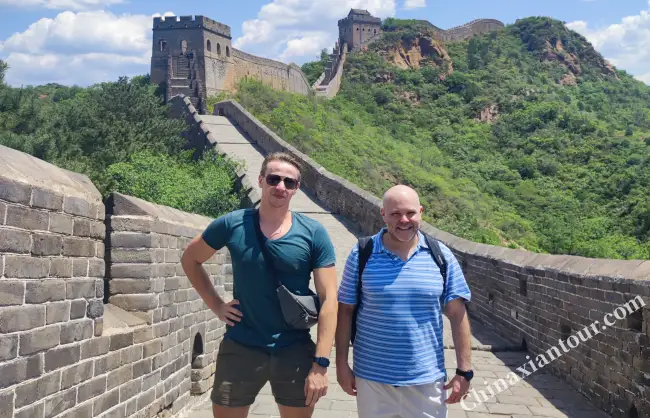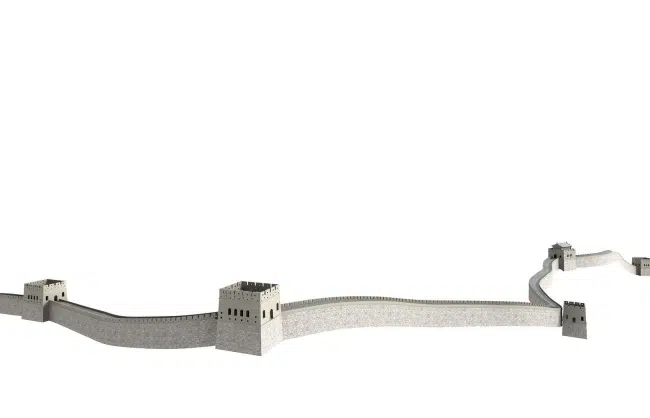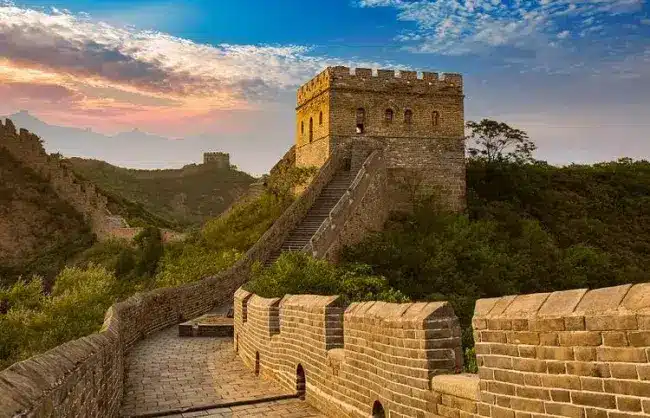The Great Wall of China stands as a remarkable ancient architectural marvel from the world. The history of the Great Wall can be traced back to the Western Zhou Dynasty and extended to the Qing Dynasty. For nearly 3,000 years, almost all dynasties had built the Great Wall.
Stretching across China’s northern border for thousands of miles, the Great Wall of China still exists today, as do the ancient ruins of its watchtowers. And, there are something a bit more modern added to the Wall, such as the cable cars, dedicated to making the Great Wall tours easier and more accessible.
Read on, explore 20 important and interesting facts about the Great Wall, shedding light on its history, construction, cultural importance, and unique features that you may never heard before.

1. The Construction of the Great Wall
China Great Wall’s construction commenced more than two millennia ago, during the West Zhou Dynasty (1064-771 BC). It was initially built as a defensive structure to protect China from invasions.
The Great Wall stretches from the desert in the west to the sea in the east. At its narrowest point, it is only about 40 cm, allowing only one person to walk on it, while at its widest point it reaches about 15 metres, allowing a pickup truck to pass through it.
In different places, the Great Wall has different specifications. It can stand on top of a mountain, on a cliff, or on a plain. The fact that it can be built according to the terrain and is not constrained by the landscape is one of the peculiarities of the Great Wall.
Read more:
2. Where is the Great Wall?
The Great Wall is located in the north of China, stretching from Shanhaiguan in Bohai Bay of Hebei Province in the east to Jiayuguan in Gansu Province in the west. The Great Wall of China is situated in the north and stretches from Jiayuguan in Gansu Province to Shanhaiguan in Hebei Province’s Bohai Bay.
It is mostly found in 15 provinces, autonomous regions, and municipalities directly under the control of the central government, including Hebei, Beijing, Tianjin, Shanxi, Shaanxi, Gansu, Inner Mongolia, Heilongjiang, Jilin, Liaoning, Shandong, Henan, Qinghai, Ningxia, and Xinjiang.
3. Who Built the Great Wall of China?
The earliest history of the construction of the Great Wall can be traced back to the Western Zhou Dynasty. At that time, occasionally some northern nomads would cross over to terrorize the common inhabitants of the Central Plains. As a result, the Western Zhou Dynasty constructed numerous castles as a means of defense. These castles marked the start of the Great Wall.
Emperor Qin Shi Huang was not the first to build the Great Wall. But he connected the northern walls of the vassal states he conquered.
√ Recommend Great Wall of China tours:
- 4 Days Beijing Essence Tour with Forbidden City and Great Wall
- 3 Days Beijing Package Tourwith Mutianyu Great Wall
- Beijing Highlight Day Tour with Great Wall
4. The Great Wall Length and Dimensions
One of the most important Great Wall of China facts is that how long it is.
In ancient Chinese history, the Great Wall was continually lengthened and heightened and thickened. The vassal states of the Central Plains that bordered the steppe took the initiative to build it.
After unifying China and establishing the Qin Dynasty, Emperor Qin Shi Huang connected the Great Walls of Qin, Zhao and Yan vassal states. The Great Wall of the Qin, Han and early periods exceeded 10,000 kilometers, with a total length of over 21,000 kilometers.
The Ming Dynasty, the last dynasty to build the Great Wall, also reached a length of 8,851.8 kilometers. The Great Wall we see today spans 15 provinces and cities, including Gansu and Shaanxi, Henan, Hebei and Shandong, connecting almost all of China’s northern provinces, traversing plains, mountains, deserts, and grasslands.
Today, the total length of the Great Wall the entire construction is 21,196.18 kilometres (13,171 miles) long.

5. The Great Wall is Not Continuous
Another fact of the Great Wall of China is that it is made up of a series of walls separated by fortifications and natural barriers, such as mountain ranges and rivers.
Today, many sections of the Great Wall in Beijing, Tianjin, and Jiayuguan, are open to visitors, such as Mutianyu, Jinshanling, Simatai, Huanghuacheng, and Badaling. Each has its own unique history and features. Some parts of them are very well preserved, some have been restored, and some others are lost in the ruins.
6. The 13 Famous Passes of the Great Wall
The Great Wall has thirteen dangerous passes, distributed horizontally from east to west: Shanhai Pass, Huangyaguan, Juyongguan, Zijingguan, Peking Pass, Pingxingguan, Yantouguan, Yanmenguan, Niangziguan, Jianhukou Pass, Jiayuguan, Yangguan, and Yumenguan.
Most of the materials used to build the Great Wall were stone or special wood. Except for those in desert areas, they have been preserved for a long time (except for human damage).
Read more:
7. What Was the Great Wall Made of?
Next , we come to the fact of the the Great Wall construction materials, which involved a wide range of materials, including stone, brick, wood, and even compacted earth. In some sections, workers used a mixture of sticky rice flour and slaked lime as mortar.
During the Ming Dynasty, people added a unique ingredient to the mortar to build the Wall: glutinous rice. Glutinous rice was mixed with slaked lime, sand, and water to hold the bricks in place and tie them together so tightly that weeds can’t grow in many places.

8. Can You See the Great Wall from Space?
This is one of the fun Great Wall facts. Contrary to popular belief, the Great Wall cannot be seen from space with the naked eye. It is a common misconception that originated in the early 20th century but has been debunked by astronauts and scientific evidence.
9. Is the Great Wall of China Filled with Dead Bodies?
There is a popular claim (including in films and television programmes) that workers who died during the construction of the Great Wall of China were buried inside the Wall. However, there is little evidence to support this claim.
Historians believe that to build the Wall required a great deal of labour and resources. The Great Wall’s labour force consisted of soldiers, peasants who were forced to recruit, guilty men and prisoners of war.
While it is true that working conditions on the Wall were harsh and that workers were exposed to extreme heat, cold and other hazards, there is no historical record of anyone being buried alive. However, depending on the customs of the time, workers who died during the construction of the Wall may have been given a proper burial.
√Recommended Great Wall Tours from Beijing :
- Beijing No-shopping Group Tour to Mutianyu Great Wall
- 2 Days Beijing Stopover Tour: Great Wall+Forbidden City
- 2 Days Wild Great Wall Trekking & Camping Tour
10. Historical and Cultural Significance
One of world’s 7 wonders, the Great Wall of China served as a military defensive project against invasions from nomadic tribes and foreign powers. For more than 2,000 years, it witnessed countless wars, conquests, as well as cultural exchanges, representing China’s achievements in science, engineering and architecture.

10 More Cool facts about the Great Wall of China:
- The Great Wall is the longest man-made structure on Earth.
- In 1987, the Great Wall was designated as a UNESCO World Heritage site, for its outstanding universal value and contribution to humanity’s cultural heritage.
- There are bullet holes in the Gubeikou section of the Great Wall, which is evidence of the last battle of the Great Wall.
- The Great Wall served as a communication network using smoke signals and beacon fires.
- The most popular Great Wall legend is about Meng Jiangnu, whose husband died building the Wall. Her weeping was so painful that part of the Wall collapsed, revealing her husband’s bones, so she buried him.
- The Badaling Great Wallis the first part open to visitors. More than 300 heads of state and dignitaries from around the world have visited Badaling.
- Simatai GreatWall is illuminated at night, and welcome visitors with a night tour.
- Parts of the Great Wall in the Northwest (e.g., Gansu and Ningxia Provinces) may disappear in 20 years due to desertification and changes in human land use.
- The Great Wall has been featured in numerous movies and TV shows, boosting its global recognition.However, the film The Great Wall, starring Matt Damon, was not filmed on the Wall.
- The Great Wall Marathon is held every October at the Mutianyu Great Wall.
√Recommended China Tours including the Great Wall:
- 8 Days Beijing & Xian Family Tour by Bullet Train
- 9 Days Private China Tour of Shanghai, Xian and Beijing
- 10 Days Great China Tour of Beijing-Xian-Guilin-Shanghai









